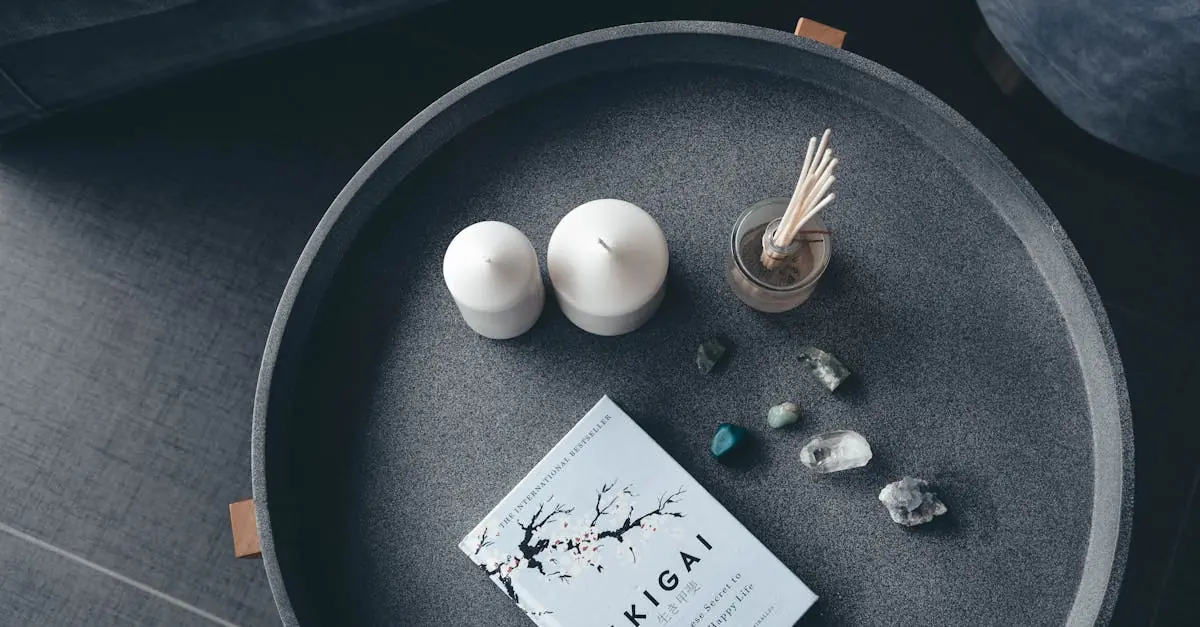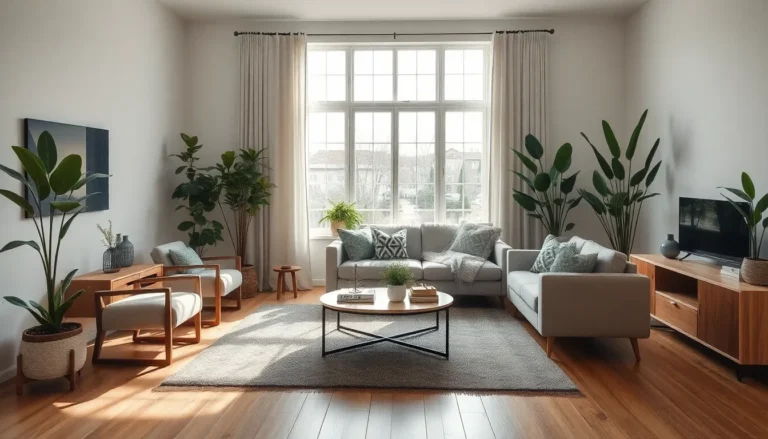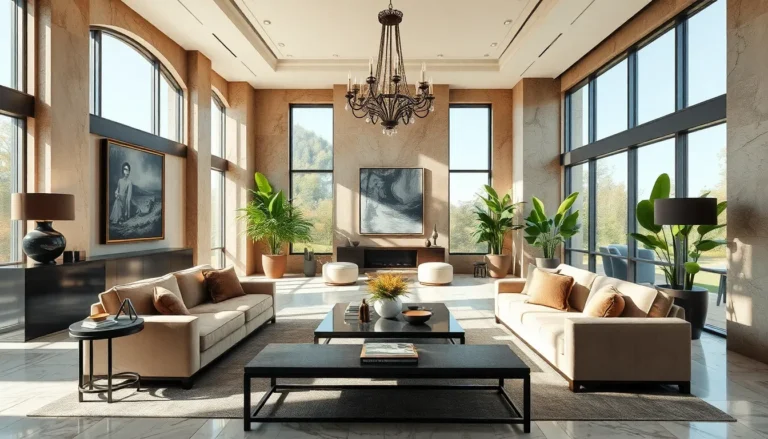Table of Contents
ToggleImagine stepping into a space where chaos fades away and tranquility takes the spotlight. A zen room isn’t just a corner of your home; it’s a sanctuary where stress gets the boot and serenity reigns supreme. Whether it’s a cozy nook for meditation or a stylish retreat for unwinding, the right inspiration can transform any room into a peaceful haven.
What Is Zen Room Inspiration?
Zen room inspiration centers around creating a calming environment that fosters mindfulness and serenity. This concept integrates elements of simplicity, nature, and functionality to achieve a peaceful atmosphere. Artists emphasize balance, using soft colors and minimalistic decor to cultivate tranquility.
Incorporating natural materials like wood, stone, and textiles enhances the peaceful vibe. Select plants or small water features help connect the room to nature. Choosing low-lighting options can further soften the ambiance, promoting relaxation.
Furniture selection plays a vital role in establishing a zen space. Opt for pieces that reflect clean lines and simple forms, avoiding clutter. Functionality remains prioritized; every element should serve a purpose while contributing to the overall serenity.
Inspiration may also derive from various cultural influences. Traditional Japanese aesthetics influence many zen spaces, emphasizing symmetry and harmony. Techniques such as kansei design focus on the emotional response a space evokes.
A zen room often acts as a personal retreat. Individuals create spaces that invite quiet reflection and meditation, allowing them to recharge. Emphasizing original artwork or meaningful symbols invites personal connection, enhancing the space’s emotional depth.
Creating a zen room involves thoughtful planning and intentionality. Each design choice should support relaxation and mindfulness. Ultimately, the goal remains to develop a haven that encourages peace and serenity in everyday life.
Key Elements of Zen Room Design
Creating a zen room involves essential elements that foster tranquility. These components combine to create a calming atmospheric space suitable for relaxation and meditation.
Color Palette
Neutral colors create serenity in a zen room. Shades of beige, soft greens, and muted blues evoke nature and promote relaxation. Earthy tones connect the space to the environment, allowing for a harmonious feel. Additionally, accents of warmer colors can energize while maintaining an overall soothing effect. Selecting a cohesive color scheme promotes visual unity, aiding in distraction reduction.
Furniture Selection
Minimalistic furniture plays a critical role in zen room design. Pieces with clean lines and simple silhouettes contribute to a clutter-free environment. Practicality and comfort are essential when choosing items like cushions, mats, and low seating. Often, natural materials like wood and bamboo enhance the organic feel of the space. Choosing functional furniture encourages movement and flexibility, creating an area that supports meditation and mindfulness practices.
Lighting Choices
Natural light enhances the calming atmosphere of a zen room. Large windows or skylights allow sunlight to cascade into the space, uplifting spirits and promoting well-being. Soft, diffused lighting options such as paper lanterns or dimmable lamps create an inviting ambiance. Warm-toned bulbs mimic candlelight, fostering a sense of relaxation. Thoughtful placement of lighting elements can highlight focal points, defining areas for meditation and reflection.
Creating a Tranquil Atmosphere
Creating a tranquil atmosphere is vital for a zen room. Key elements such as nature and minimalism foster the quiet needed for reflection and relaxation.
Incorporating Nature
Integrating natural elements enhances the serenity of a zen room. Plants like succulents or bamboo provide freshness and vibrancy. Natural light brightens the space, connecting it to the outdoors. Consider using wooden furniture or stone accents that embody organic textures. Natural fabrics, such as cotton or linen for cushions, add softness without overwhelming the senses. These elements together create a calming environment that promotes mindfulness.
Minimizing Clutter
Minimizing clutter ensures a peaceful space for meditation and relaxation. Choose only essential items that serve a purpose, promoting functionality over excess. Use storage solutions like baskets or hidden compartments to keep the area tidy. Arranging furniture with open pathways encourages flow and movement, reducing feelings of confinement. A clean aesthetic arises from maintaining open surfaces and desks, supporting a tranquil mind. Each choice contributes to the overall simplicity that defines a zen room.
Zen Room Inspiration Ideas
Creating a zen room requires thoughtful design choices, whether in small spaces or dedicated home offices. Focus on elements that promote relaxation and mindfulness.
Small Spaces
Small spaces can transform into serene zen rooms with the right approach. Utilize vertical storage solutions to keep surfaces clear, which minimizes clutter. A few strategically placed plants enhance the natural vibe, providing freshness to the space. Incorporate light, neutral colors on walls to make areas appear larger and more inviting. Choose multi-functional furniture that serves multiple purposes, such as a bench with storage underneath. This choice maintains a clean aesthetic while offering practicality. Incorporate cushions for added comfort, allowing for a cozy reading nook or meditation corner. Each element should contribute to the overall tranquility of the environment.
Home Offices
Home offices also benefit from zen room inspiration. Ensure that the workspace promotes calm through organized layouts and minimal distractions. Position the desk near windows to harness natural light, boosting mood and productivity. Use warm, soft lighting options for late hours, creating a soothing atmosphere. Incorporate natural materials, like wood or bamboo, in furniture selections to foster a connection with nature. Choose artwork or decor that inspires peace, such as landscapes or abstract designs with muted colors. Implement a dedicated area for relaxation, complete with a comfortable chair or mat for quick breaks. Prioritize simplicity to enhance focus and reduce stress in an otherwise busy environment.
Creating a zen room is about crafting a personal sanctuary that nurtures tranquility and mindfulness. By focusing on simplicity and natural elements, anyone can transform a space into a calming retreat. Thoughtful design choices like minimalistic furniture and soft lighting play a crucial role in fostering a peaceful atmosphere.
Incorporating plants and natural materials enhances the connection to nature, while a cohesive color palette promotes relaxation. Whether it’s a small corner of a home or a dedicated office space, the essence of a zen room lies in its ability to provide a serene escape from daily stressors. Embracing these principles allows individuals to cultivate a space that truly reflects their desire for peace and reflection.







